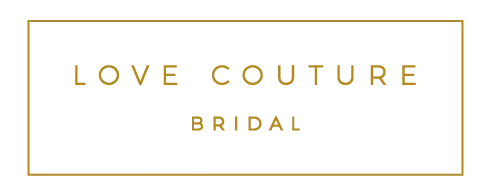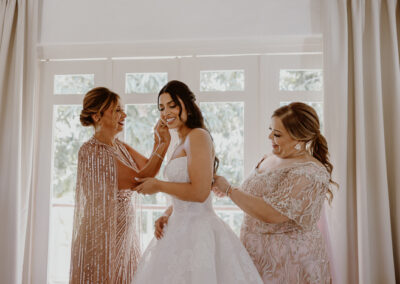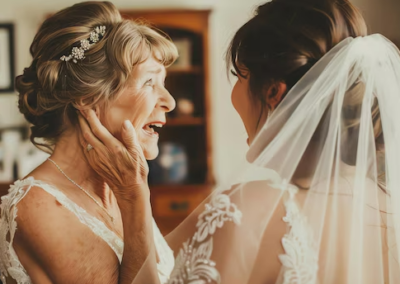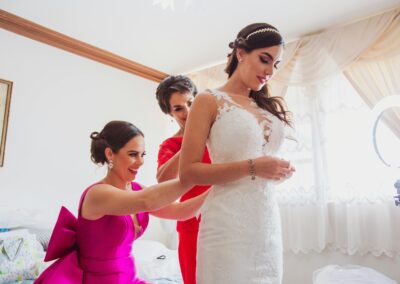What Is a Wedding Wardrobe Called?
When you’re planning a wedding, deciding how much to spend on a dress can be a challenging task. You might wonder if you should stick to the typical 10% of the total budget or let your heart lead you to a pricier gown. It’s essential to balance dreams with practicality, reflecting on the variety of options from budget-friendly to high-end. But what about those hidden costs, like alterations or accessories, that can quickly add up? There’s more to reflect on than just the price tag and understanding these factors can guide you towards making a wise investment.

Understanding Wedding Dress Codes
Understanding the nuances of wedding etiquette is essential for selecting appropriate guest attire. The black tie dress code demands elegance, typically reserved for evening events. Men should don tuxedos with bow ties, while women wear floor-length gowns crafted from high-quality fabrics. It’s the most formal after white tie, leaving little room for personal interpretation. Visit your nearest bridal shop to learn more.
For formal dress codes, a notch below black tie, women can choose between floor-length gowns or sophisticated cocktail dresses. Men should opt for dark suits with ties or tuxedos. Attention to detail is key, including polished shoes and sleek hairstyles.
The semi-formal dress code bridges the gap between casual and black tie. Women can wear cocktail dresses or chic pantsuits, while men should select suits or dress pants with blazers. Classic colors and accessories enhance the ensemble, maintaining sophistication without exceeding formality. Men can also consider adding a pocket square to their attire to further elevate their look.
The Elegance of White-Tie Attire
What defines the pinnacle of elegance and tradition in formal attire? White-tie attire, with its origins in the 1800s, represents timeless elegance and sophisticated style at its core. Reserved for the grandest of occasions, such as royal banquets and formal weddings, this dress code emphasizes the importance of formality and tradition. Men are expected to don evening tailcoats paired with full-dress trousers, a full-dress shirt, and a white bow tie, while a waistcoat completes the ensemble. Complementary accessories include patent leather Oxfords, a pocket watch, and a boutonniere. A black top hat may be added for outdoor events to signify refinement and complete the look.
For women, a floor-length evening gown is essential, with the option to add elbow-length white gloves for added sophistication. Formal jewelry and a clutch bag enhance the ensemble, while footwear should be patent leather or metallic heels. White-tie attire’s strict adherence to prescribed elements showcases respect for both the occasion and its attendees, embodying a legacy of grandeur.
Defining Black-Tie Expectations
When attending a black-tie event, understanding the expectations is essential for presenting oneself with the appropriate level of sophistication and elegance. Black tie signifies a formal affair usually held in the evening, necessitating specific attire. For men, a black tuxedo serves as the centerpiece, ideally crafted from black wool with satin peak lapels. It should be complemented by a white dress shirt featuring a Marcella bib front and French cuffs, a black silk bow tie, and a cummerbund or vest to achieve a streamlined appearance. Accessories include cufflinks and a dress watch, while black patent leather shoes are the standard footwear choice. For women, traditionally, full-length gowns are expected to be worn, and opting for embellished gowns can enhance the elegance suitable for such an evening. Event etiquette demands a polished appearance and behavior that reflects the occasion’s formality. Seasonal considerations might affect fabric and color choices, but guests should adhere closely to the traditional attire guidelines while conducting themselves with moderation and respect throughout the event.
Exploring Black-Tie Optional
Though black-tie optional events offer more flexibility than traditional black-tie affairs, they still require a careful balance between elegance and personal style. Understanding black tie nuances is key to steering through this dress code successfully. Guests have the option to don their most formal attire, such as evening gowns or tuxedos, but can also embrace attire flexibility with formal suits and cocktail dresses.
Men can choose between a classic tuxedo or a dark formal suit, complemented by a tie or bowtie. Adding a vest to a three-piece suit can elevate formality, while subtle patterns and textures enhance style. Women might opt for floor-length gowns, yet tea-length or midi dresses are equally acceptable. Alternative options include cocktail dresses and suits for a more relaxed formal look. For those seeking variety, formal jumpsuits and structured cocktail dresses offer stylish alternatives.
Fabrics like satin, tulle, and jacquard with embellishments enhance formality, while considering the venue and season guarantees an outfit aligns with the event’s ambiance.
Navigating Cocktail Attire
After maneuvering through the elegance and flexibility of black-tie optional attire, guests often find themselves considering the nuances of cocktail attire. Cocktail attire, a step down in formality yet still polished, requires a keen understanding of cocktail essentials and appropriate color choices. For men, a suit jacket paired with a button-down shirt and dress pants is fundamental, while women can opt for a cocktail dress, jumpsuit, or a skirt-and-top combination. Structured jumpsuits with belts accentuate the figure, making them a popular choice for women attending such events. Color choices typically revolve around black, navy blue, and neutral tones, with nighttime weddings inviting darker shades and elegance. Accessories should be minimal; women may choose a clutch or small bag, and men might consider patterned jackets. Avoid overdressing with tuxedos or gowns and steer clear of underdressing with jeans or mini-skirts. Footwear should not include overly casual options like sneakers. By adhering to these guidelines, guests will effortlessly navigate the cocktail attire landscape.
Discovering Semi-Formal Attire
Semi-formal attire strikes a harmonious balance between elegance and comfort, making it a popular choice for weddings. This dress code encompasses refined yet relaxed garments such as suits, cocktail dresses, and dressy jumpsuits, allowing personal expression within traditional boundaries. Seasonal colors play a significant role, with lighter hues favored for spring and summer weddings, while darker tones are preferred in fall and winter. For men, a well-tailored suit in navy, charcoal, or black paired with a crisp dress shirt forms the foundation. Styling accessories like ties, watches, and pocket squares enhance sophistication. Women can opt for knee-length dresses in fabrics like chiffon or satin or choose tailored pantsuits. Elegant footwear, complemented by statement jewelry or clutches, completes the look. Considering the wedding’s time and location, coordinating with partners, and ensuring well-fitted attire are essential for maintaining a polished, cohesive appearance. Semi-formal attire serves as a bridge between formal and casual wear, offering flexibility while sustaining a celebratory atmosphere.
Casual Dress Code Considerations
When planning for a wedding with a casual dress code, understanding the balance between comfort and style is critical. Casual dress codes focus on laid-back elegance, steering clear of overly casual items like shorts and flip-flops. Instead, guests are encouraged to select attire made of casual fabrics like cotton or linen, which offer both comfort and sophistication. Women might opt for sundresses or elegant jumpsuits, adding chic accessories such as statement jewelry to enhance their look. Men can consider button-down shirts paired with relaxed chinos, complemented by loafers or boat shoes for a polished finish. Evening weddings may call for darker colors to elevate formality, similar to the semiformal or dressy casual dress code. Seasonal and time considerations play a significant role in outfit selection. For daytime weddings, lighter colors and fabrics are recommended, whereas evening events might call for darker hues. Selecting the appropriate footwear, like sandals for women or dressy sneakers for men, guarantees both comfort and style, aligning perfectly with the casual wedding theme.
Creative Interpretations in Wedding Dress Codes
How does one navigate the vibrant domain of creative wedding dress codes? It’s an invitation to explore one’s sartorial creativity while respecting formal guidelines. In “Creative Black Tie,” attendees blend traditional elegance with artistic embellishments and alternative fabrics. Velvet suits or sequined cocktail dresses offer a formal yet distinctive flair, ideal for couples with unique styles. For “Black-Tie Optional” events, men have the flexibility to choose between a tuxedo or a dark suit, allowing for a refined yet adaptable appearance. “Festive Attire” elevates cocktail and semi-formal weddings by encouraging bold, colorful ensembles. Here, artistic embellishments, such as elaborate patterns or bursts of color, invite a celebratory touch, allowing for self-expression within a structured framework. “Themed Attire” engages guests in the wedding’s narrative, ranging from holiday-themed ensembles to period-specific styles. This approach enhances the wedding’s aesthetic, accommodating both formal and casual interpretations. Finally, “Garden Party Attire” suits upscale outdoor weddings, combining elegance with casual practicality. High-end spring dresses in alternative fabrics paired with stylish, practical shoes complete this refined yet relaxed look.



